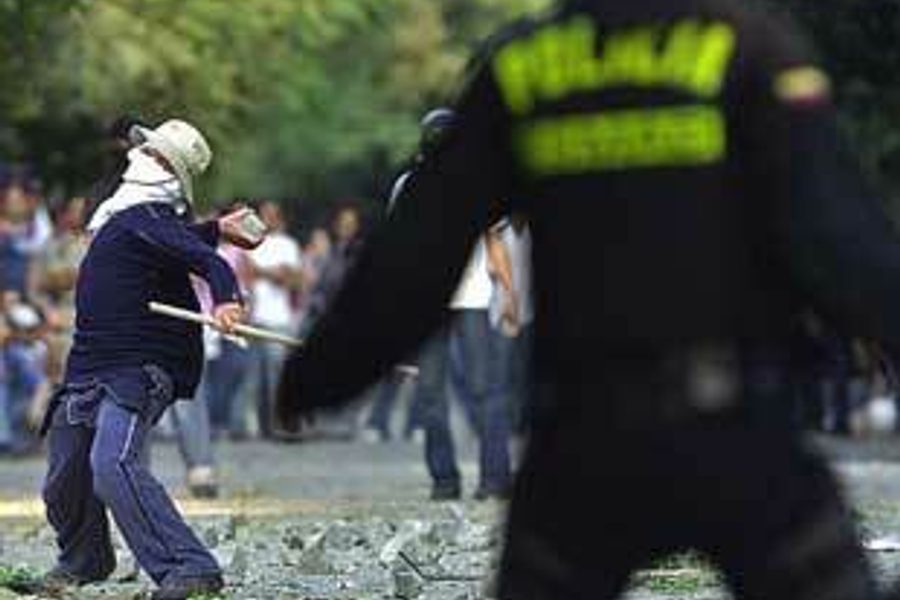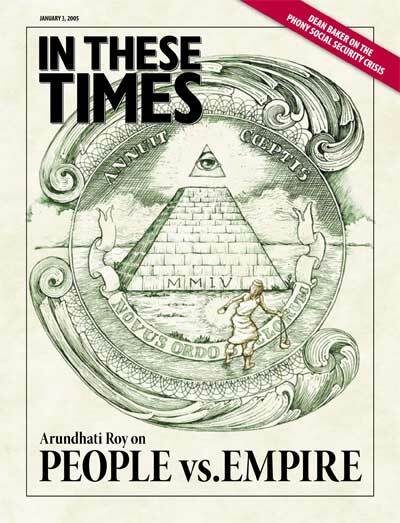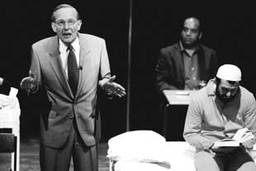War and Hope in Colombia
Despite glowing claims by Bush and Uribe, both violence and the drug trade rage on
Ana Carrigan

On his way home from the Asia-Pacific Economic Summit in Chile, President George Bush stopped off in the Caribbean city of Cartagena on November 22 to see Colombian President Alvaro Uribe Velez. Uribe is George Bush’s closest regional ally in the global anti-terrorism campaign. Known as “Bushito” (little Bush), he spared no efforts to provide suitable security for his guest.
Cartagena became a ghost town. Alcohol was banned for 24 hours, businesses shut and workers were ordered to stay home. The airport, airspace and waters of Cartagena Bay were closed. Combat helicopters and fighter planes patrolled the sky, and naval submarines and armed patrol boats guarded the waters of the silent port. As sharpshooters crouched along rooftops, 15,000 army, navy and police troops lined the streets, alongside 1,200 black-clad anti-riot police and numerous plainclothes secret police, 50 bomb-sniffing dogs and two anti-explosive robots. Meanwhile, an American aircraft carrier stood anchored at the entrance to the bay.
Bush spent three and a half hours on Colombian soil. He was the guest at a lengthy lunch party and posed for photos with Orlando Cabrera, the Colombian-born shortstop for the Boston Red Sox. At an event billed as a “press conference,” the press were permitted four questions before Bush closed down the proceedings and departed, thirty minutes ahead of schedule. The two leaders read lengthy statements congratulating each other on their successes in the fight against narco-terrorists and drugs and noted that their policies were strengthening Colombia’s democracy, protecting human rights and promoting the rule of law.
“President Uribe and I share a basic optimism. This war against narco-terrorism can and will be won and Colombia is well on its way to that victory,” said Bush. “My nation will continue to help Colombia prevail in this vital struggle.”
Translation: “Plan Colombia,” the $4 billion counter-narcotics program, launched during the Clinton administration and extended from counter-narcotics to counter-terrorism in August 2002, will be continued when it expires next year.
Following 9/11, the FARC guerrillas have lost their identity as a peasant insurgency sustained by endemic rural poverty and morphed into an “illegal armed group” of “narco-terrorists.” It now seems inevitable that, pursuant to its status as a new front in the global anti-terror campaign, Colombia will continue to attract U.S. military involvement in its endless, 40-year-old conflict.
Both governments proclaim their policies are working. The White House reports that aerial fumigation of coca fields has cut cultivation by 20 percent for the second year running. Drug seizures have prevented tons of cocaine from reaching the United States. Captures of drug traffickers have escalated and Uribe has signed record numbers of U.S. extradition orders.
Yet, these statistics don’t tell the whole story. The White House cannot explain why there has been no impact yet on the streets of U.S. cities, and the drug czar has not even acknowledged that, according to the most recent figures from the Rand Corporation, the price of street cocaine in the United States has actually fallen by 31 percent since Plan Colombia began in 2000.
Meanwhile, no one admits to the impact indiscriminate chemical fumigation has on food crops, farm animals and water supplies, although last month a senior government adviser resigned to protest the government’s failure to monitor the health effects. In desperately poor, remote areas, where farmers have no alternative way of making a living, the arrival of American spray planes sends young peasant recruits into the war and drives their desperate parents to uproot themselves and grow the crop elsewhere. In the last two years, coca cultivation has spread from 12 Colombian provinces to 23.
Another gulf between official claims and the experience of ordinary Colombians centers on President Uribe’s internal security policies. Of course, those who live in an upper- or middle-class residential area in any major town and wish to travel along the highways between the big cities may find Uribe’s security policies brilliant. Deploying troops in towns and along major highways during weekends, he has slashed the number of kidnappings and lowered the murder rate. It is now safe for wealthy Colombians to travel to their farms, or to visit their friends, or simply to party all night. The less fortunate may beg to differ.
And it remains unclear whether the counterinsurgency war is going well. Backed by U.S. intelligence and logistics, “Plan Patriot,” the Colombian army’s most aggressive counterinsurgency campaign in living memory, has pushed the FARC guerrillas out of the towns and back into remote rural areas. But Plan Patriot has not lived up to its promises, failing to capture a single FARC leader or to release a single FARC hostage. In the special war zone Uribe created in the oil-rich Arauca region on the border with Venezuela — where U.S. Special Forces guard Occidental Petroleum’s pipeline — the new military tactics that were supposed to “liberate” the zone by using paid informers to root out civilian guerrilla sympathisers have failed spectacularly; Arauca is more violent than ever. And in those areas where the army has routed the FARC, the army coordinates its operations with the paramilitaries, who remain behind to consolidate their control, substituting one form of tyranny for another.
Meanwhile, the poor living in the war zones are caught in the crossfire, with both sides suspecting them of sympathizing with the enemy. War opponents, government dissidents, human rights defenders, union organizers, and indigenous and community leaders have been “disappeared,” killed, or fingered by one of the government’s millions of paid informants and then swept up in the mass arrests that, according to the inspector general, detained 125,000 people in the first six months of this year on “fragile evidence.” So long as the paramilitary ceasefire agreement remains a fiction, the usual killers still stalk Uribe’s Colombia. They have murdered 1,900 people since the “para” talks began two years ago.
In the midst of this bleak scenario, Colombian Foreign Secretary Carolina Barco’s announcement that the Colombian government and the FARC have jointly requested the Swiss government to help them reach a humanitarian accord for the release of the FARC’s hostages has shined a welcome, humane light into the surrounding gloom. Even in Colombia, hope dies last.







